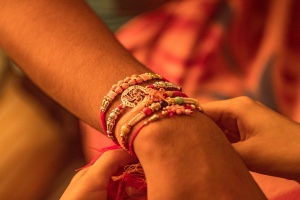
Sunday Snippets
 By Venkatesh Raghavan
By Venkatesh Raghavan
In my childhood days, though not rich in any mythology or folklore behind the festivals we observe, I was well able to tell the festival by the sweets and preparations that came my way. For instance, on Gokhulashtami, I would be showered with sweets prepared from jaggery besides “rava laddoos.” When it was Ganpati, I used to get modaks and rice-mixed sweet preparations. On Nariyal Purnima (Raksha Bandhan) I used to get tilgul and puran polli. Though not the favourite of the Gods and not very keen on visiting places of worship, I always used to feel these festivals are an occasion to look forward to for satiating my palate.
Let me launch into a narrative about Nariyal Purnima that is also observed as Raksha Bandan. When in the second year of my primary school, our class teacher told us that the festival is celebrated by throwing coconuts into the sea. After a couple of years however, as my knowledge of geography expanded, it threw up a question. “Where do people toss the coconuts in areas where there is no sea?” Agreed, a geographical bias sets in when discussing local festivals. I then queried a friend in our locality who happened to be a native Marathi speaker. He narrated to me that it was about bonding between brother and sister in which, the sister ties a rakhi on your hands and the brother parts with money, signifying protection of the weaker sex by the brother.
In my high school years, I used to see boys displaying multiple rakhis tied on their hands proudly. It indeed is a good feeling to take pride in a good number of girls regarding them as a brother. To feel reassured by the presence of a brother is indeed what every sister seeks.
But there was a flip-side of the story too during our growing up years. Entering into my graduation years, I sensed that there was a high degree of reluctance in permitting girls studying with us, to tie the rakhi. The reason being it restricted the options available to boys from their wish list of girlfriends.
Subsequently, being a student of GN Khalsa College in central Mumbai, I got to learn about how couples dating in their early college years went about it. To protect themselves from competition, they both used to play the role of brother and sister in front of the college seniors. This used to go on well, with tying of rakhis and other such acts of bonhomie between siblings. A couple of years after they graduated from college, word used to get around that “brother” and “sister” have tied the knot.
I had little personal experience when it came to rakhis. It was only a cousin sister of my mother who was just three years elder to me, though technically my aunt, who used to tie the rakhi on my hand. However, due to the busy Mumbai lifestyle, and over-stretched office hours even on a Raksha Bandhan day, finally on one such occasion, as I returned late from office, my mother said she had kept a rakhi for me and asked for me to tie it on myself.





